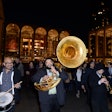
Melinda Kendall, vice president of business solutions for Freeman, knows how to improve attendees’ experience at trade shows.
“There are still an awful lot of shows where the show floor is for booth space and the goal is to sell out,” Kendall said. "But our role as show organizers is to draw people not just to the building but on to the show floor, engage with them so they have a great experience, and have them spend as long as possible on the show floor. The trade show floor is simply too important to leave to the exhibitors.”
Kendall led a session Tuesday on the topic at A.I.B.T.M., the Americas Meetings and Events Exhibition, which wraps up today at the Baltimore Convention Center. Produced by Reed Travel Exhibitions, the event attracted more than 1,700 planners from corporate, government, association, and nonprofit organizations from the United States and around the world.
To create an engaging trade show, planners should focus on two things: the design of the floor and the inclusion of interactive content. Here are Kendall’s top tips in those areas:
Design:
1. Group similar products together in zones to draw like-minded buyers.
2. Provide lounges, either one large space or multiple smaller spaces spread throughout the show floor. “We are trying to bring buyers and sellers together to talk to each other, so let’s let them sit down,” Kendall said. "Create areas where people can get to know each other and do business."
3. Move the biggest exhibitors away from the front door. “The American Institute of Architects has created what it calls the 'Avenue,' a wide aisle across the back third of the show floor,” Kendall said. "The big booths are hung off this aisle, along with small eating areas, some of the interactive content, the keynote at one end, and the association area at the other end. It becomes the main drag. This gives much more traffic to the smaller booths in front as people make their way to the avenue in the back.”
4. Highlight new products: “This can be really low-tech, such as skirted tables displaying products, all the way up to what the Sweets & Snacks Expo does, which is gorgeous retail display cases with products behind glass,” Kendall said. "Each new product has a bar code in front of it, and attendees use a scanner to scan the ones they are interested in and it prints out a map of the show floor showing you where to find those companies."
Content:
5. Put education on the show floor, such as small group discussions and presentation theaters: “You can sell speaking opportunities to exhibitors, or you can curate them so only really interesting new product announcements or new technologies can present,” Kendall said. "It depends on your goals and your industry. But always keep them short and keep them moving."
6. Create demonstration areas.
7. Hold award ceremonies on the show floor.
8. Incorporate "gamification": “You can take the old-fashioned passport program up a notch to make it more of an electronic scavenger hunt,” Kendall said. "Or create interactive games about your industry using touch-screen plasma or smartphones. All of these get people moving around the show floor. People love to compete, they love to see their name on a leader board."



















